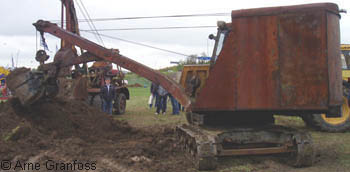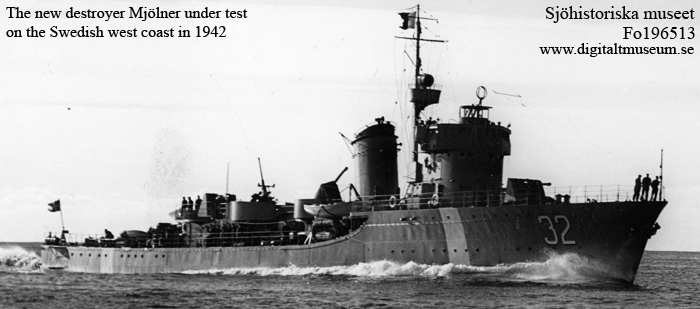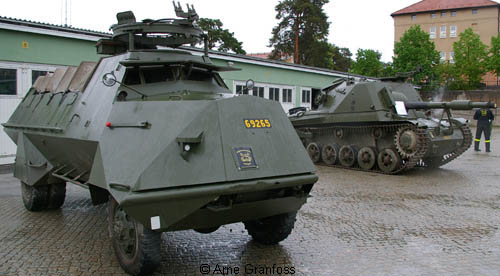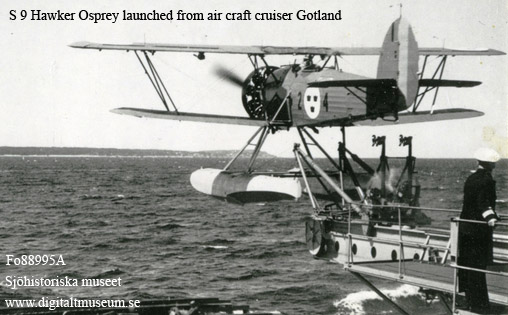Swedish defence in WWII

 UNDER CONSTRUCTION Version 0.41
UNDER CONSTRUCTION Version 0.41
|
Sweden in World War II - across borders
|
 |
![]()
Sweden had not invested so much in military defence after World War I, and did not do so much about it during the first half of the 1930s either.
On this page you will find a short description of the situation in 1939, and some fragments about what happened during the war.
![]()
The size of the armies in some countries, as a comparison:
| Country | Population | Army |
| Sweden | 6 310 000 (1939) | 300 000 |
| Germany | 85 327 000 (1939) | 2 000 000 |
| Poland | 35 090 000 (1939) | 1 600 000 |
| Denmark | 3 793 000 (1939) | 200 000 |
| Finland | 3 630 000 (1938) | 200 000 |
| Norway | 2 921 000 (1939) | 100 000 |
Norway had no standing army. Since the Soviet Union attack on Finland in September 1939 there was a partly mobilization in northern Norway. [s01]
In the extraordinary mobilization in Sweden in 1940, there were 400 000 soldiers. [s09]
During 1943 the risk of a German military action against Sweden had decreased, with Germanys large offensive into the Soviet Union and their lost battle at Stalingrad. And Swedens defence capabilities had reached a considerable level. [s75]
![]()
Navy
During World War I the Swedish navy had been useful for Sweden, among others for the protection of merchant ships in Swedish waters and the critical situation on the Finnish islands Åland in 1916-1918. [s68]
The defence cuts decided in 1925 were not so hard on the navy as on the army, but only two of the four coastal artillery units remained. Four coastal forts would no longer be used, and many elder ships would not be replaced when discarded. [s68]
When WWII began in 1939, Sweden had 97 warships - of these 47 were various patrol ships and 16 submarines. Less than one third of them were younger than 10 years. [s70]
In 1925 Älvsborgs coastal artilleri corps, who had manned a battery near Gothenburg, was closed down and the battery kept as reserve. In September 1939, when Germany attacked Poland, the battery was manned with men from other corps in Sweden. (Their first test with a gun resulted in hundreds of broken windows in newer houses built nearby.) After the Soviet Union attack on Finland the temporary group of men was moved to the northeastern coast of Sweden, and there they were also around 9 April 1940 when German forces passed near Gothenburg on their way to attack Norway. [s72]
Main tasks for the navy during the winter 1939-1940 were mining of strategic Swedish waters and escort for civil shipping. [s68]
In April 1940, at the time of the German attack on Denmark and Norway, the Swedish navy had 6 ships on the west coast. 1 larger armoured ship from 1904, 2 destroyers from 1917, and 3 submarines from 1917-1918. [s71]
The German attack on Denmark and Norway led to increased naval defence in the area of the Swedish islands Gotland and Öland. From August 1940 Denmark, Germany and Sweden cooperated in mine sweeping in Öresund between Denmark and Sweden. The main tasks continued to shift depending on the development of the war near Sweden. But, there were problems due to lack of fuel oil and petrol. [s68]
In 1942 Sweden decided to modernize the navy, with a larger focus on destroyers, motor torpedo boats and submarines. (Two cruisers were also ordered, but not delivered until 1947.) [s68]

25 elder warships were scrapped during the war, 10 purchased from other countries and 82 were constructed in Sweden. [s68]

In June - October 1942, when Soviet Union submarines were active in the Baltic Sea, the Swedish navy escorted 9,000 ships in Swedish waters. Of the probably 5 Swedish civil ships that were sunk by these submarines, 2 sailed with escort and 3 sailed without escort. The total of escorted ships in Swedish waters in 1942 was 10,340. [s68]
In August 1943 the Swedish navy had its peak in active force. Two decisions in Sweden in 1943 were followed with increased military preparedness. In April a stop for German ships to sail between the Swedish mainland and the Swedish islands when passing in Swedish waters, and in August a stop of German troop transit on Swedish railways. At the time the Swedish navy had 6 larger armoured ships, 4 cruisers, 21 destroyers, 16 larger and 26 smaller mine sweepers, 15 motor torpedo boats, 20 submarines and a number of smaller ships in use. [s68]

![]()
During WWII 50-70 fishing boats were used by the Swedish navy for mine-sweeping, in addition to the naval ships. [s71]
![]()
In 1941 the Swedish defence minister managed to get the decision to also build two new cruisers. The first was ready for operations in 1946, the other in 1947. [s71]
![]()
Army
A Swedish officer once expressed that 'in 1943 we had the number of material that we really didn't want to have, and when we also had material of the quality we wanted - then the war was over'. [s71]


![]()
![]()
Air force
On 24 April 1939 Sweden had 106 warplanes more or less disposable. Of these were 32 fighters (Gloster Gladiator) and 53 bombers, the rest were reconnaissance planes. Two examples of "more or less": Of the fighters only 3 had got radio installed, and a number of the fighters would have to use propellers with small cracks in case of a mobilisation within short time. [s75]
![]()
In the late 1930s, after the Swedish rearmament decision, Sweden began to order planes from various countries. Neither Dutch, French, German or U.S.A. companies delivered according to the orders. As late as February 1940, 144 planes were ordered from the U.S.A. - but none were delivered. Of orders for 343 planes of 7 models, 2 planes were delivered. [s75]
The search went on in other countries. Italy sold among others 84 planes, that had been manufactured for France. These were meant to be fitted with French engines, so some extra work was required. [s75]
![]()
What the Swedish air force had from 1939:
Fighters: 28 fighters taken into service in 1930, and 55 Gloster Gladiator in service from 1937. In 1940-1941 192 planes were taken into service, of the makes Seversky EP-106, Fiat C.R. 42 and Reggiane Re 2000. In late 1943 the first Swedish-made FFVS 22 was delivered, less than three years after Bo Lundberg got the task to construct a new fighter - 200 planes came into service. [s75]
Bombers and attack planes: 45 Hawker Hart from 1934 and 56 Junkers Ju 86K from 1937. From 1940 103 Northrop 8A-1 (manufactured under license by ASJA (Saab), 2 (two) Republic 2 P-A Guardsman and 84 Caproni Ca 313. Saab L10/Saab 17 got into service from 1941 (132) and Saab L11/Saab 18 from 1944 (245). [s75]
(I have seen Swedish-built Northrop 8A-1 (in Sweden named B 5) several times, although none of them remains. They star in many in-the-air scenes in the Swedish 1941 movie "Första divisionen", foremost in dive-bombing practise but also equipped with skis during winter - and more. A movie I recommend.)
![]()
![]()
![]()
In March 1942 the first SAAB-constructed warplane was delivered, the SAAB 17. Totally more than 320 SAAB 17 were produced in reconnaissance and bomber versions, with three different engine types - from Bristol, Pratt&Whitney and Piaggio (not Swedish-constructed). [s75]

SAAB B 17
The Swedish-made fighter J22 was delivered from October 1943, less than three years after Bo Lundberg got the order to develop a Swedish fighter plane. Among the demands on the plane was that it should have a chance in combat with planes like Spitfire and Messerschmitt Bf 109 - the J22 could make 575 km/h. Produced by "Flygförvaltningens Verkstäder i Stockholm, FFVS" (started by the Swedish state, in order not to disturb the production at SAAB), with around 500 Swedish companies as suppliers of parts (foremost companies that didn't already deliver to SAAB), and final assembly in a hangar at the public airport Bromma in Sweden. [s75]
From March 1944 the second SAAB plane model was delivered, the SAAB B 18. These had 'pirate copied' Pratt&Whitney Twin Wasp STW-C3 engines. [s75]
![]()
A German air force general described the Swedish air force as 'skilled pilots, zippy leadership (Bengt Nordenskjöld, air force chief from 1942) but a completely unsatisfying set of airplanes'. [s71]

2019-04-07. www.granfoss.se. Text/pictures: Arne Granfoss